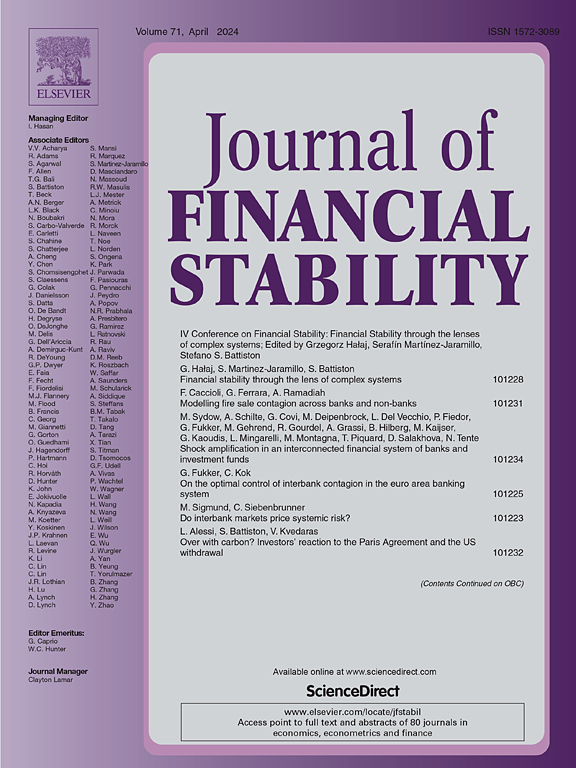部门信贷配置和系统性风险
IF 4.2
2区 经济学
Q1 BUSINESS, FINANCE
引用次数: 0
摘要
我们研究了国家层面部门信贷动态和银行层面系统性风险之间的关系。与大多数只深入研究基础广泛的信贷发展的研究相反,我们关注的是部门信贷分配,特别是家庭与企业,以及可贸易部门与不可贸易部门。基于2000年至2014年期间46个国家417家银行的全球样本,我们发现,向非贸易部门的家庭和企业提供贷款与整个系统的困境呈正相关。相反,授予企业和可交易部门的信贷与银行的系统性行为呈负相关。子样本分析表明,家庭贷款的风险通过小银行传导,而非贸易贷款的风险通过大银行传导。此外,新兴市场和发展中经济体的银行在家庭和贸易信贷增长较快的背景下表现出更强的系统性行为,而发达经济体非贸易部门企业的信贷往往会增加银行的系统性脆弱性。同样,危机前和危机后时期的结果也有所不同,完整的样本结果受到危机后时间跨度的影响。研究结果强调了考虑到部门异质性、银行规模、银行注册所在国以及金融稳定/不稳定时期的关键政策影响。当局可以干预最具系统性的经济部门,限制“不良信贷”的积累,保持系统弹性,同时仍然受益于“良好信贷”对增长和金融稳定的积极影响。本文章由计算机程序翻译,如有差异,请以英文原文为准。
Sectoral credit allocation and systemic risk
We examine the association between country-level sectoral credit dynamics and bank-level systemic risk. Contrary to most studies that only delve into broad-based credit development, we focus on sectoral credit allocation, specifically to households versus firms, and to the tradable versus non-tradable sector. Based on a global sample of 417 banks across 46 countries over the period 2000–2014, we find that lending to households and corporates in the non-tradable sector is positively associated with system-wide distress. Conversely, credit granted to corporations and to the tradable sector negatively correlates with banks’ systemic behavior. Sub-sample analysis shows that risks from household lending are transmitted through small banks, whereas non-tradable lending is transmitted through large banks. Moreover, banks located in emerging market and developing economies exhibit enhanced systemic behavior against the backdrop of higher household and tradable credit growth, whereas credit to non-tradable sector firms tends to increase systemic fragility of banks in advanced economies. By the same token, the results differ for the pre-crisis and crisis/post-crisis periods, with the full sample findings driven by the crisis/post-crisis timespan. The findings emphasize critical policy implications considering sectoral heterogeneity, bank size, country of incorporation of banks, and periods of financial tranquillity/instability. Authorities can intervene in the most systemic economic sectors and limit the accumulation of “bad credit” and preserve systemic resilience, while still benefiting from the positive impact of “good credit” on growth and financial stability.
求助全文
通过发布文献求助,成功后即可免费获取论文全文。
去求助
来源期刊

Journal of Financial Stability
Multiple-
CiteScore
7.70
自引率
9.30%
发文量
78
审稿时长
34 days
期刊介绍:
The Journal of Financial Stability provides an international forum for rigorous theoretical and empirical macro and micro economic and financial analysis of the causes, management, resolution and preventions of financial crises, including banking, securities market, payments and currency crises. The primary focus is on applied research that would be useful in affecting public policy with respect to financial stability. Thus, the Journal seeks to promote interaction among researchers, policy-makers and practitioners to identify potential risks to financial stability and develop means for preventing, mitigating or managing these risks both within and across countries.
 求助内容:
求助内容: 应助结果提醒方式:
应助结果提醒方式:


